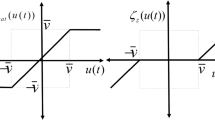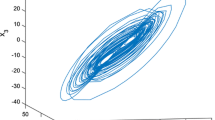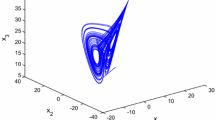Abstract
In this paper, new control approaches for synchronization the master and the slave chaotic systems is established by means of novel coupled chaotic synchronous observers and coupled chaotic adaptive synchronous observers. The simultaneous estimation of the master and the slave systems’ states is accomplished, by means of the proposed observers for each of the master and the slave systems, to produce error signals between these estimated states. This estimated synchronization error signal and the state-estimation errors converge to the origin by means of a specific observers-based feedback control signal to ensure synchronization as well as state estimation. Using Lyapunov stability theory, nonadaptive and adaptive control laws and properties of nonlinearities, a convergence condition for the state-estimation errors and the estimated synchronization error is developed in the form of nonlinear matrix inequalities. Solution of the resulted inequality constraints using a two-step approach is presented, which provides the necessary and sufficient condition to obtain values of the observer gain and controller gain matrices. Further, a method requiring less computational efforts for solving the matrix inequalities for obtaining the observer and the controller gain matrices using decoupling technique is also proposed. Numerical simulation of the proposed synchronization technique for FitzHugh–Nagumo neuronal systems is illustrated to elaborate efficaciousness of the proposed observers-based control methodologies.












Similar content being viewed by others
References
Ott, E., Grebogi, C., Yorke, J.A.: Controlling chaos. Phys. Rev. Lett. 64, 1196–1199 (1990). doi:10.1103/PhysRevLett.64.1196
Strogatz, S.H.: Nonlinear Dynamics and Chaos: With Applications to Physics, Biology, Chemistry and Engineering. Westview Press, USA (1994)
Chadli, M., Zelinka, I.: Chaos synchronization of unknown inputs Takagi–Sugeno fuzzy: application to secure communications. Comput. Math. Appl. 68, 2142–2147 (2014). doi:10.1016/j.camwa.2013.01.013
Gonzalez-Miranda, J.M.: Synchronization and Control of Chaos. An Introduction for Scientists and Engineers. Imperial College Press, UK (2004). ISBN 9781860944888
Carroll, T., Pecora, L.: Synchronizing chaotic circuits. IEEE Trans. Circuits Syst. 38, 453–456 (1991). doi:10.1109/31.75404
Yassen, M.T.: Controlling chaos and synchronization for new chaotic system using linear feedback control. Chaos Soliton Fract. 26, 913–920 (2005). doi:10.1016/j.chaos.2005.01.047
Ali, A.: Synchronization and secure communication of uncertain chaotic systems based on full-order and reduced-order output-affine observers. Appl. Math. Comput. 219, 10000–10011 (2013). doi:10.1016/j.amc.2013.03.133
Beyhan, S.: Runge–Kutta model-based nonlinear observer for synchronization and control of chaotic systems. ISA Trans. 52, 501–509 (2013). doi:10.1016/j.isatra.2013.04.005
Ramirez, J.P., Fey, R.H.B., Nijmeijer, H.: Synchronization of weakly nonlinear oscillators with Huygens’ coupling. Chaos: an interdisciplinary. J. Nonlinear Sci. 23, 033118 (2013). doi:10.1063/1.4816360
Rehan, M., Hong, K.-S.: Robust synchronization of delayed chaotic FitzHugh–Nagumo neurons under external electrical stimulation. Comput. Math. Methods Med. 2012, Article ID 230980 (2012). doi:10.1155/2012/230980
Zaheer, M.H., Rehan, M., Mustafa, G., Ashraf, M.: Delay-range-dependent chaos synchronization approach under varying time-lags and delayed nonlinear coupling. ISA Trans. 53, 1716–1730 (2014). doi:10.1016/j.isatra.2014.09.007
Jeong, S.C., Ji, D.H., Park, J.H., Won, S.C.: Adaptive synchronization for uncertain chaotic neural networks with mixed time delays using fuzzy disturbance observer. Appl. Math. Comput. 219, 5984–5995 (2013). doi:10.1016/j.amc.2012.12.017
Njah, A.N.: Tracking control and synchronization of the new hyperchaotic Liu system via backstepping techniques. Nonlinear Dyn. 61, 1–9 (2010). doi:10.1007/s11071-009-9626-5
Yang, C.C.: Adaptive control and synchronization of identical new chaotic flows with unknown parameters via single input. Appl. Math. Comput. 216, 1316–1324 (2010). doi:10.1016/j.amc.2010.02.026
Yang, C.C.: Adaptive synchronization of Lü hyperchaotic system with uncertain parameters based on single-input controller. Nonlinear Dyn. 63, 447–454 (2011). doi:10.1007/s11071-010-9814-3
Yang, J., Zhu, F.: Synchronization for chaotic systems and chaos-based secure communications via both reduced-order and step-by-step sliding mode observers. Commun. Nonlinear. Sci. Numer. Simul. 18, 926–937 (2013). doi:10.1016/j.cnsns.2012.09.009
Mbe, E.S.K., Fotsin, H.B., Kengne, J., Woafo, P.: Parameters estimation based adaptive generalized projective synchronization (GPS) of chaotic Chua’s circuit with application to chaos communication by parametric modulation. Chaos Solitons Fract. 61, 27–37 (2014). doi:10.1016/j.chaos.2014.02.004
Liu, B., Wang, L., Jin, Y.-H., Huang, D.-X., Tang, F.: Control and synchronization of chaotic systems by differential evolution algorithm. Chaos Solitons Fract. 34, 412–419 (2007). doi:10.1016/j.chaos.2006.03.033
Filal, R.L., Benrejeb, M., Borne, P.: On observer-based secure communication design using discrete-time hyperchaotic systems. Commun. Nonlinear Sci. Numer. Simul. 19(15), 1424–1432 (2014). doi:10.1016/j.cnsns.2013.09.005
Boutayeb, M., Darouach, M., Rafaralahy, H.: Generalized state-space observers for chaotic synchronization and secure communication. IEEE Trans. Circuits Syst. 49, 345–349 (2002). doi:10.1109/81.989169
Yang, J., Zhu, F.: Synchronization for chaotic systems and chaos-based secure communications via both reduced-order and step-by-step sliding mode observers. Commun. Nonlinear Sci. Numer. Simul. 18, 926–937 (2013). doi:10.1016/j.cnsns.2012.09.009
Li, Y.N., Chen, L., Cai, Z.S., Zhao, X.Z.: Experimental study of chaos synchronization in the Belousov–Zhabotinsky chemical system. Chaos Solitons Fract. 22, 767–771 (2004). doi:10.1016/j.chaos.2004.03.023
Steinmetz, P.N., Roy, A., Fitzgerald, P.J.: Attention modulates synchronized neuronal firing in primate somatosensory cortex. Nature 404, 457–490 (2000). doi:10.1038/35004588
Meffo, L.P., Woafo, P., Domnganga, S.: Cluster states in a ring of four coupled semiconductor lasers. Commun. Nonlinear Sci. Numer. Simul. 12, 942–952 (2007). doi:10.1016/j.cnsns.2005.10.002
Mirollo, R.E., Strogatz, S.H.: Synchronization of pulse-coupled biological oscillators. SIAM J. Appl. Math. 50, 1645–1662 (1990). doi:10.1137/0150098
Angeles, R., Nijmeijer, H.: Mutual synchronization of robots via estimated state feedback: a cooperative approach. IEEE T. Contr. Syst. Technol. 12, 542–554 (2004). doi:10.1109/TCST.2004.825065
Kuhnert, L., Agladze, K.I., Krinsky, V.I.: Image processing using light sensitive chemical waves. Nature 337, 244–247 (1989). doi:10.1038/337244a0
Ömer, M., Ercan, S.: Observer based synchronization of chaotic systems. Phys. Rev. E 54, 4803–4811 (1996). doi:10.1103/PhysRevE.54.4803
Heagy, J.F., Carroll, T., Pecora, L.: Synchronous chaos in coupled oscillator systems. Phys. Rev. E 50, 1874–1885 (1994). doi:10.1103/PhysRevE.50.1874
Senejohnnya, D.M., Delavari, H.: Active sliding observer scheme based fractional chaos synchronization. Commun. Nonlinear Sci. Numer. Simul. 17(11), 4373–4383 (2012). doi:10.1016/j.cnsns.2012.03.004
Bagheri, P., Shahrokhi, M., Salarieh, H.: Adaptive observer-based synchronization of two non-identical chaotic systems with unknown parameters. J. Vib. Control. (2015). doi:10.1177/1077546315580052
Jeong, S.C., Ji, D.H., Park, J.H., Won, S.C.: Adaptive synchronization for uncertain chaotic neural networks with mixed time delays using fuzzy disturbance observer. Appl. Math. Comput. 219, 5984–5995 (2013). doi:10.1016/j.amc.2012.12.017
Grassi, G.: Observer-based hyperchaos synchronization in cascaded discrete-time systems. Chaos Solitons Fract. 40, 1029–1039 (2009). doi:10.1016/j.chaos.2007.08.060
Wen, S., Zeng, Z., Huang, T.: Observer-based synchronization of memristive systems with multiple networked input and output delays. Nonlinear Dyn. 78, 541–554 (2014). doi:10.1007/s11071-014-1459-1
Raghavan, S., Hedrick, J.K.: Observer design for a class of nonlinear systems. Int. J. Control 59, 515–528 (1994). doi:10.1080/00207179408923090
Rajamani, R.: Observers for Lipschitz nonlinear systems. IEEE Trans. Autom. Control 43, 397–401 (1998). doi:10.1109/9.661604
Zeitz, M.: The extended Luenberger observer for nonlinear systems. Syst. Control Lett. 9, 149–156 (1987). doi:10.1016/0167-6911(87)90021-1
Huang, H., Huang, T., Chen, X., Qian, C.: Exponential stabilization of delayed recurrent neural networks: a state estimation based approach. Neural Netw. 48, 153–157 (2013). doi:10.1016/j.neunet.2013.08.006
Che, Y.-Q., Wang, J., Chan, W.-L., Tsang, K.-M.: Chaos synchronization of coupled neurons under electrical stimulation via robust adaptive fuzzy control. Nonlinear Dyn. 61, 847–857 (2010). doi:10.1007/s11071-010-9691-9
Yang, C.-C., Lin, C.-L.: Robust adaptive sliding mode control for synchronization of space-clamped FitzHugh–Nagumo neurons. Nonlinear Dyn. 69, 2089–2096 (2012). doi:10.1007/s11071-012-0410-6
Acknowledgments
This work was supported by Higher Education Commission (HEC) of Pakistan by supporting Ph.D. studies of the first author through indigenous Ph.D. scholarship program (phase II, batch II, 2013).
Author information
Authors and Affiliations
Corresponding author
Appendices
Appendix 1: Proof of Theorem 2
Using (10)–(12), CCAS observers (22)–(23) and systems (1)–(2) reveal the error systems as
Applying \(\tilde{\theta }_\mathrm{m} (t)=\theta _\mathrm{m} -\hat{{\theta }}_\mathrm{m} (t)\) and \(g_\mathrm{m} (x_\mathrm{m} (t))=Bg(x_\mathrm{m} (t))\theta _\mathrm{m} \) and, further, employing the mathematical fact
we obtain
Similarly, it is implicit to obtain
Using \(u_g =g(\hat{{x}}_\mathrm{m} (t))\hat{{\theta }}_\mathrm{m} -g\left( {\hat{{x}}_\mathrm{s} (t)} \right) \hat{{\theta }}_\mathrm{s} \), we have
Consider the Lyapunov function
Its time derivative along (39)–(41), by employing \(B^\mathrm{T}P_\mathrm{m} -R_\mathrm{m} C=0\) and \(B^\mathrm{T}P_\mathrm{s} -R_\mathrm{s} C=0\), is given by
Using Assumption 1 for positive scaling factors \(\beta _1 \) and \(\beta _2 \), we have
Employing the above inequalities, using (43), \(\dot{\tilde{\theta }}_\mathrm{m} (t)=-\dot{\hat{{\theta }}}_\mathrm{m} (t)\) and \(\dot{\tilde{\theta }}_\mathrm{s} (t)=-\dot{\hat{{\theta }}}_\mathrm{s} (t)\) and incorporating the adaptation laws (24)–(25) under Assumption 2, it implies that
which further reveals
If (26) is satisfied, the above inequality (44) implies \(\dot{V}(t) < 0 \). Hence, the errors \(e_\mathrm{m} (t), e_\mathrm{s} (t)\) and \(e_\mathrm{o} (t)\) converge to the origin, which entails synchronization of the master and the slave chaotic oscillators. \(\square \)
Appendix 2: Proof of Theorem 4
Applying the congruence transformation, that is, by pre- and post- multiplying (33) by \(\mathrm{diag} (I_n , I_n ,I_n ,\beta _1 I_n ,\alpha _1 I_n ,)\), where \(\beta _1 =1/{\eta _1 \bar{{\beta }}_1 }\) and \(\alpha _1 =1/{\eta _1 \bar{{\alpha }}_1 }\) for an appropriate number \(\eta _1 \), the resultant matrix inequality
is obtained. Employing Schur complement obtains
Similarly, by using \(\beta _2 =1/{\eta _2 \bar{{\beta }}_2 }\), and \(\alpha _2 =1/{\eta _2 \bar{{\alpha }}_2 }\) for a scalar \(\eta _2 \), and following the same procedure as above, the matrix inequality (34) can be modified as
By application of congruence transformation to (35) using \(\mathrm{diag}(I_n ,I_n ,\alpha _3 I_n ,\alpha _3 I_n ,)\), where \(\alpha _3 =1/{\bar{{\alpha }}_3 }\), the resultant inequality is obtained as
By applying Schur complement, we achieve
Since we have
Consequently, we obtain
By considering \(H_3 =F\bar{{P}}_\mathrm{o} \) and applying congruence transformation by \(\mathrm{diag}(P_\mathrm{o} , P_\mathrm{o} )\), it results into
By lumping together the linear matrix inequalities (46), (47), and (48) and, further, using \(H_1 =\tilde{P}_\mathrm{m} L_\mathrm{m} \) and \(H_2 =\tilde{P}_\mathrm{s} L_\mathrm{s} \), it produces
We can regenerate the matrix inequality (26), by pre- and post-multiplying (49) by \( [\mathbb {I}_1^\mathrm{T} , \mathbb {I}_4^\mathrm{T} , \mathbb {I}_7^\mathrm{T} , \mathbb {I}_2^\mathrm{T} , \mathbb {I}_5^\mathrm{T} , \mathbb {I}_8^\mathrm{T} , \mathbb {I}_3^\mathrm{T} , \mathbb {I}_6^\mathrm{T} ]^\mathrm{T}\) and its transpose, respectively, where \(\mathbb {I}_{\alpha } \) is the matrix generated by replacing the ith \(0_{n\times n} \) with \(I_n \) in \(0_{n\times 8n} \) matrix (for example \(\mathbb {I}_2 = [0_{n\times n} , I_n, 0_{n\times n} , 0_{n\times n} , 0_{n\times n}, 0_{n\times n},0_{n\times n} ,0_{n\times n} ])\) and substituting \(\tilde{P}_\mathrm{m} =\eta _1 ^{-1}P_\mathrm{m} \),\(\tilde{P}_\mathrm{s} \,{=}\,\eta _1 ^{-1}P_\mathrm{s} \), \(\bar{{P}}_\mathrm{o} \,{=}\,P_\mathrm{o}^{-1} \), \(\bar{{\alpha }}_1 \,{=}\,1/{(\eta _1 \alpha _1 )}\), \(\bar{{\alpha }}_2 =1/{(\eta _2 \alpha _2 )}\), \(\bar{{\alpha }}_3 \,{=}\,\alpha _3 ^{-1}\), \(\bar{{\beta }}_1 \,{=}\,1/{(\eta _1 \beta _1 })\), and \(\bar{{\beta }}_2 \,{=}\,1/{(\eta _2 \beta _2 })\).
Rights and permissions
About this article
Cite this article
Siddique, M., Rehan, M. A concept of coupled chaotic synchronous observers for nonlinear and adaptive observers-based chaos synchronization. Nonlinear Dyn 84, 2251–2272 (2016). https://doi.org/10.1007/s11071-016-2643-2
Received:
Accepted:
Published:
Issue Date:
DOI: https://doi.org/10.1007/s11071-016-2643-2




